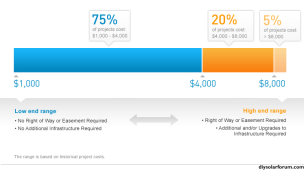I was part of the NEM 2.0 rush in April 2023. My interconnect application indicated a system size of 5.4kW DC, 3.84kW AC (Enphase microinverters, no storage). My monthly household usage is about 1,000 kWh. I DIYed the system, and successfully tested it in September.
I was approved for NEM 2.0, but recently received notice that PG&E needs to do a transformer upgrade in my neighborhood before they can give PTO. They aren't making me pay for it, unlike last year when I tried to upgrade from a 100-amp main to 200, and they said I would have to pay for the transformer (of course I abandoned that upgrade). But they say it'll take until Summer 2024 to replace the transformer, and obviously I'm annoyed to leave a new PV system idle for almost a year.
I asked the NEM team how in the world a 3.84kW backfeeding system could be a concern for an overloaded transformer. Here's my grade-school math:
Option 1: I never turn on the system and continue to draw 1,000 kWh/month.
Option 2: I turn on the system and generate the absolute maximum (let's say 6 full hours per day at 3.8kW, or about 680 kWh/month). I offset my own consumption, so now the load on the grid is 320 kWh/month. Better for the transformer.
Option 3: I go completely bonkers and stop using electricity entirely. I still generate the same PV power as in Option 2. I'm feeding 680 kWh monthly to the grid. Load is smaller than Option 1, but higher than Option 2 (albeit in the reverse direction). Better for the transformer.
Under all these scenarios, the load on the transformer is equal to or less than my current usage.
What is PG&E's deal? Is reverse power harder on transformers than forward power? Or are they just saying no because they can?
(Just to clarify, I'm not quibbling with the transformer upgrade; I assume that's legit. I'm wondering why they're blocking PTO on the upgrade.)
I was approved for NEM 2.0, but recently received notice that PG&E needs to do a transformer upgrade in my neighborhood before they can give PTO. They aren't making me pay for it, unlike last year when I tried to upgrade from a 100-amp main to 200, and they said I would have to pay for the transformer (of course I abandoned that upgrade). But they say it'll take until Summer 2024 to replace the transformer, and obviously I'm annoyed to leave a new PV system idle for almost a year.
I asked the NEM team how in the world a 3.84kW backfeeding system could be a concern for an overloaded transformer. Here's my grade-school math:
Option 1: I never turn on the system and continue to draw 1,000 kWh/month.
Option 2: I turn on the system and generate the absolute maximum (let's say 6 full hours per day at 3.8kW, or about 680 kWh/month). I offset my own consumption, so now the load on the grid is 320 kWh/month. Better for the transformer.
Option 3: I go completely bonkers and stop using electricity entirely. I still generate the same PV power as in Option 2. I'm feeding 680 kWh monthly to the grid. Load is smaller than Option 1, but higher than Option 2 (albeit in the reverse direction). Better for the transformer.
Under all these scenarios, the load on the transformer is equal to or less than my current usage.
What is PG&E's deal? Is reverse power harder on transformers than forward power? Or are they just saying no because they can?
(Just to clarify, I'm not quibbling with the transformer upgrade; I assume that's legit. I'm wondering why they're blocking PTO on the upgrade.)





